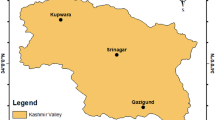Abstract
The standardized form of the well-known FAO Penman-Monteith equation, published by the Environmental and Water Resources Institute of the American Society of Civil Engineers (ASCE-EWRI), is recommended as a standard procedure for calculating reference evapotranspiration (ET ref) and subsequently plant water requirements. Applied and validated under different climatic conditions it generally achieved good results compared to other methods. However, several studies documented deviations between measured and calculated reference evapotranspiration depending on environmental and weather conditions. Therefore, it seems generally advisable to evaluate the model under local environmental conditions. In this study, reference evapotranspiration was determined at a subhumid site in northeastern Austria from 2005 to 2010 using a large weighing lysimeter (ET lys). The measured data were compared with ET ref calculations. Daily values differed slightly during a year, at which ET ref was generally overestimated at small values, whereas it was rather underestimated when ET was large, which is supported also by other studies. In our case, advection of sensible heat proved to have an impact, but it could not explain the differences exclusively. Obviously, there were also other influences, such as seasonal varying surface resistance or albedo. Generally, the ASCE-EWRI equation for daily time steps performed best at average weather conditions. The outcomes should help to correctly interpret ET ref data in the region and in similar environments and improve knowledge on the dynamics of influencing factors causing deviations.








Similar content being viewed by others
References
Aboukhaled A, Alfaro A, Smith M (1982) Lysimeters. In: FAO (ed) Irrigation and drainage paper 39. Food and agriculture organization of the United Nations, Rome, 73 pp
Allen RG, Smith M, Perrier A, Pereira LS (1994) An update for the definition of reference evapotranspiration. ICID Bulletin 43(2):1–34
Allen RG, Pereira LS, Raes D, Smith M (1998) Crop evapotranspiration: guidelines for computing crop water requirements. In: FAO (ed) Irrigation and drainage paper 56. Food and agriculture organization of the United Nations, Rome
Allen RG, Pruitt WO, Wright JL, Howell TA, Ventura F, Snyder R, Itenfisu D, Steduto P, Berengena J, Baselga Yrisarry J, Smith M, Pereira LS, Raes D, Perrier A, Alves I, Walter I, Elliott R (2006) A recommendation on standardized surface resistance for hourly calculation of reference ETo by the FAO56 Penman–Monteith method. Agric Water Manag 81:1–22. doi:10.1016/j.agwat.2005.03.007
ASCE-EWRI (2005) The ASCE standardized reference evapotranspiration equation. In: Allen RG, Walter IA, Elliott R, Howell T, Itenfisu D, Jensen M (eds.) ASCE-EWRI Task committee report. American Society of Civil Engineers, Reston, VA, 171 pp
Berengena J, Gavilán P (2005) Reference evapotranspiration estimation in a highly advective semiarid environment. J Irrig Drain Eng 131(2):147–163. doi:10.1061/(ASCE)0733-9437(2005)131:2(147)
Doorenbos J, Pruitt WO (1977) Guidelines for predicting crop water requirements. In: FAO (ed) Irrigation and drainage paper 24. Food and agriculture organization of the United Nations, Rome, 175 pp
Garcia M, Raes D, Allen R, Herbas C (2004) Dynamics of reference evapotranspiration in the Bolivian highlands (Altiplano). Agric For Meteorol 125(1–2):67–82
Gavilán P, Berengena J, Allen RG (2007) Measuring versus estimating net radiation and soil heat flux: impact on Penman-Monteith reference ET estimates in semiarid regions. Agric Water Manag 89:275–286
Howell TA, Evett SR, Schneider AD, Dusek DA, Copeland KS (2000) Irrigated fescue grass ET compared with calculated reference grass ET. Proc. 4th National Irrigation Symposium, ASAE, Phoenix, 228-242
Irmak S, Howell TA, Allen RG, Payero JO, Martin DL (2005) Standardized ASCE Penman-Monteith: impact of sum-of-hourly vs. 24-hour timestep computations at reference weather station sites. T Asae 48:1063–1077
Jensen ME, Burman RD, Allen RG (1990) Evapotranspiration and irrigation water requirements. Manual No. 70, Am Soc Civ Eng, 332 pp
Müller W (1993) Agroklimatische Kennzeichnung des zentralen Marchfeldes. Beihefte zu den Jahrbuechern der ZAMG, Klimatologie, Heft 3. Zentralanstalt fuer Meteorologie und Geodynamik (ZAMG), Publ 348, Wien
Neuwirth F, Mottl W (1983) Errichtung einer Lysimeteranlage an der agrar-meteorologischen Station in Groß-Enzersdorf. Wetter und Leben 35:48–53
Nolz R, Kammerer G, Cepuder P (2011) Datenmanagement der wägbaren Lysimeter in Groß-Enzersdorf. In: LFZ Raumberg-Gumpenstein (ed.): Proc. 14th Lysimeter Conf., Gumpenstein, Austria, May 3-4, 2011, 33-38
Nolz R, Kammerer G, Cepuder P (2013a) Interpretation of lysimeter weighing data affected by wind. J Plant Nutr Soil Sci 176:200–208. doi:10.1002/jpln.201200342
Nolz R, Kammerer G, Cepuder P (2013b) Improving interpretation of lysimeter weighing data. J Land Man Food Env 64(1–2):27–35
Paltineanu IC, Starr JL (1997) Real-time soil water dynamics using multisensor capacitance probes: laboratory calibration. Soil Sci Soc Am J 61:1576–1585. doi:10.2136/sssaj1997.03615995006100060006x
Perez PJ, Lecina S, Castellvi F, Martinez-Cob A, Villalobos FJ (2006) A simple parameterization of bulk canopy resistance from climatic variables for estimating hourly evapotranspiration. Hydrol Process 20(3):515–532. doi:10.1002/hyp.5919
Trnka M, Zlud Z, Eitzinger J, Dubrovský M (2005) Global solar radiation in Central European lowlands estimated by various empirical formulae. Agric For Meteorol 131:54–76. doi:10.1016/j.agrformet.2005.05.002
Yoder RE, Odhiambo LO, Wright WC (2005) Evaluation of methods for estimating daily reference crop evapotranspiration at a site in the humid Southeast United States. Appl Eng Agric 21(2):197–202. doi:10.13031/2013.18153
Acknowledgments
The authors would like to thank their colleagues from IHLW and the staff from BOKU experimental farm Groß-Enzersdorf for maintaining the lysimeter facilities. They also thank the Central Institute for Meteorology and Geodynamics (ZAMG), Austria, for providing the weather data and Dr. Herbert Formayer from the Institute of Meteorology (BOKU-Met) for preparing them.
Author information
Authors and Affiliations
Corresponding author
Rights and permissions
About this article
Cite this article
Nolz, R., Cepuder, P. & Eitzinger, J. Comparison of lysimeter based and calculated ASCE reference evapotranspiration in a subhumid climate. Theor Appl Climatol 124, 315–324 (2016). https://doi.org/10.1007/s00704-015-1417-y
Received:
Accepted:
Published:
Issue Date:
DOI: https://doi.org/10.1007/s00704-015-1417-y




